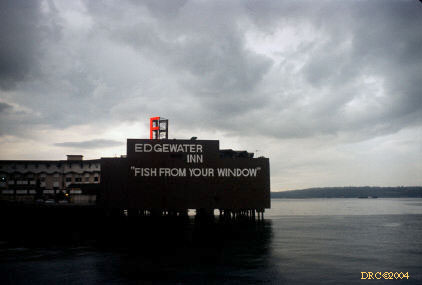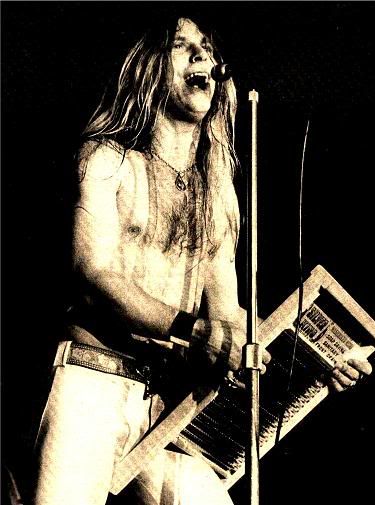
R.I.P. Scott "Bam Bam" Bigelow 1961 - 2007
Professional wrestling lost one of the best "big men" in it's history this past Friday January 19, 2006 as Scott "Bam Bam" Bigelow was found dead at the age of 45 by his girlfriend. The cause of death was unknown at the time.
I found a nice tribute video to Bam Bam from the folks at Fight Network. It can be viewed immediately below.
"The Beast From The East," Bam Bam Bigelow was known for his massive size and trademark tatooed forehead which bore red and yellow flames which matched his ring attire. Bigelow was also something of a rarity in the world of professional wrestling. A big man who could stand toe to toe in the ring with such equally massive combatants as Andre The Giant and The Undertaker, Bigelow also moved with the same agility of much smaller wrestlers like Rey Mysterio and Sean "X-Pac" Waltman.
Before retiring in 2002, Bam Bam enjoyed a long and successful career. He wrestled in all of the "big three" wrestling promotions -- WWE (World Wrestling Entertainment); WCW (World Championship Wrestling); and ECW (Extreme Championship Wrestling), as well as overseas in places like Japan, where he worked successful programs with other big men like Big Van Vader in such promotions as New Japan Wrestling.
His biggest years however were in the nineties with the then World Wrestling Federation. In Vince McMahon's WWF, he most often worked as a despised wrestling "heel" (the wrestling vernacular for "bad guy"). During his WWF tenure, Bigelow was managed by equally colorful characters like Sir Oliver Humperdink, a short, fat little man with a penchant for big cigars and loud hawaiian shirts; and Luna Vachon, the psychotic female with flamed tattoos which matched Bigelow's own.

Bigelow worked matches with most of the biggest WWF names such as Bret "Hitman" Hart (who praised his wrestling ability as being remarkable for such a big man), The Undertaker, and Hulk Hogan. In these matches, Bigelow would run the ropes with the agility of a man half his size, doing somersaults and flying off of the ropes. Bigelow's arsenal of wrestling moves even included a textbook moonsault, a move popularized by smaller wrestlers of the Lucha Libre discipline, and one which most wrestlers his size would not even dare to attempt.
His most famous match was on April 2, 1995 before a world wide pay-per-view audience at Wrestlemania 11, where he headlined a main event against NFL star Lawrence "LT" Taylor. Largely because of the pro-football connection, the match garnered massive mainstream media coverage. Bigelow, who worked the match playing the heel role he was most accustomed to, lost to "LT".

"The Beast From The East," Bam Bam Bigelow was known for his massive size and trademark tatooed forehead which bore red and yellow flames which matched his ring attire. Bigelow was also something of a rarity in the world of professional wrestling. A big man who could stand toe to toe in the ring with such equally massive combatants as Andre The Giant and The Undertaker, Bigelow also moved with the same agility of much smaller wrestlers like Rey Mysterio and Sean "X-Pac" Waltman.
Before retiring in 2002, Bam Bam enjoyed a long and successful career. He wrestled in all of the "big three" wrestling promotions -- WWE (World Wrestling Entertainment); WCW (World Championship Wrestling); and ECW (Extreme Championship Wrestling), as well as overseas in places like Japan, where he worked successful programs with other big men like Big Van Vader in such promotions as New Japan Wrestling.
His biggest years however were in the nineties with the then World Wrestling Federation. In Vince McMahon's WWF, he most often worked as a despised wrestling "heel" (the wrestling vernacular for "bad guy"). During his WWF tenure, Bigelow was managed by equally colorful characters like Sir Oliver Humperdink, a short, fat little man with a penchant for big cigars and loud hawaiian shirts; and Luna Vachon, the psychotic female with flamed tattoos which matched Bigelow's own.

Bigelow worked matches with most of the biggest WWF names such as Bret "Hitman" Hart (who praised his wrestling ability as being remarkable for such a big man), The Undertaker, and Hulk Hogan. In these matches, Bigelow would run the ropes with the agility of a man half his size, doing somersaults and flying off of the ropes. Bigelow's arsenal of wrestling moves even included a textbook moonsault, a move popularized by smaller wrestlers of the Lucha Libre discipline, and one which most wrestlers his size would not even dare to attempt.
His most famous match was on April 2, 1995 before a world wide pay-per-view audience at Wrestlemania 11, where he headlined a main event against NFL star Lawrence "LT" Taylor. Largely because of the pro-football connection, the match garnered massive mainstream media coverage. Bigelow, who worked the match playing the heel role he was most accustomed to, lost to "LT".

In another of his more noteworthy matches--this time for ECW--Bigelow created one of the most visually stunning images ever seen on a wrestling TV show, slamming the pint-sized Spike Dudley clear through the ring and onto the floor. The visual effect has since been duplicated many times, but never with quite the same impact.


Bigelow's death at the young age of 45 is the latest of what has been a disturbingly common string of wrestlers to die so young in recent years. Many of these deaths, such as those of Brian Pillman and Rick Rude, are widely believed to be at least partially the result of performance enhancing and pain relieving drugs. Many wrestlers use such drugs to keep up with the demanding schedules and physical punishment their bodies are forced to endure. Recently, World Wrestling Entertainment--far and away the world's biggest wrestling promotion--adopted a "wellness policy" in an effort to prevent such premature death among it's athletes. This policy followed the passing of one of it's biggest stars, Eddie Guerrero about a year ago. The causes of Scott "Bam Bam" Bigelow's death this past Friday remain to be determined.

Scott "Bam Bam" Bigelow, dead at age 45, will be missed by wrestling fans from America to Japan, and throughout the world.

Scott "Bam Bam" Bigelow, dead at age 45, will be missed by wrestling fans from America to Japan, and throughout the world.








.JPG)









